
A herbivore is an animal anatomically and physiologically adapted to eating plant material, for example foliage or marine algae, for the main component of its diet. As a result of their plant diet, herbivorous animals typically have mouthparts adapted to rasping or grinding. Horses and other herbivores have wide flat teeth that are adapted to grinding grass, tree bark, and other tough plant material.

In the fields of horticulture and botany, the term deciduous means "falling off at maturity" and "tending to fall off", in reference to trees and shrubs that seasonally shed leaves, usually in the autumn; to the shedding of petals, after flowering; and to the shedding of ripe fruit. The antonym of deciduous in the botanical sense is evergreen.

Heliconia is a genus of flowering plants in the monotypic family Heliconiaceae. Most of the ca 194 known species are native to the tropical Americas, but a few are indigenous to certain islands of the western Pacific and Maluku in Indonesia. Many species of Heliconia are found in the tropical forests of these regions. Most species are listed as either vulnerable or data deficient by the IUCN Red List of threatened species. Several species are widely cultivated as ornamentals, and a few are naturalized in Florida, Gambia, and Thailand.

A frugivore is an animal that thrives mostly on raw fruits or succulent fruit-like produce of plants such as roots, shoots, nuts and seeds. Approximately 20% of mammalian herbivores eat fruit. Frugivores are highly dependent on the abundance and nutritional composition of fruits. Frugivores can benefit or hinder fruit-producing plants by either dispersing or destroying their seeds through digestion. When both the fruit-producing plant and the frugivore benefit by fruit-eating behavior the interaction is a form of mutualism.
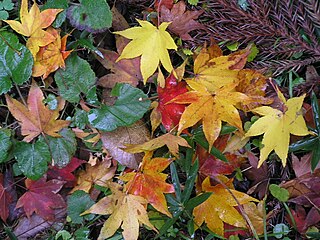
Autumn leaf color is a phenomenon that affects the normal green leaves of many deciduous trees and shrubs by which they take on, during a few weeks in the autumn season, various shades of yellow, orange, red, purple, and brown. The phenomenon is commonly called autumn colours or autumn foliage in British English and fall colors, fall foliage, or simply foliage in American English.
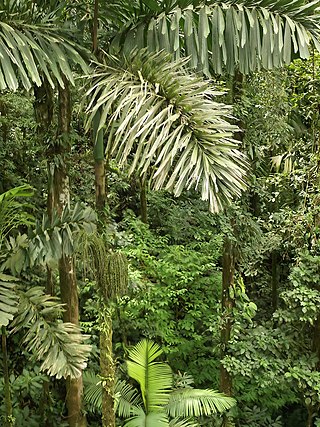
Socratea exorrhiza, the walking palm or cashapona, is a palm native to rainforests in tropical Central and South America. It can grow to 25 metres in height, with a stem diameter of up to 16 cm, but is more typically 15–20 m tall and 12 cm in diameter. It has unusual stilt roots, the function of which has been debated. Many species of epiphyte have been found growing on the palms. The palm is pollinated by beetles, and various organisms eat its seeds or seedlings.

The maroon langur, maroon leaf monkey, or red leaf monkey is a member of the family Cercopithecidae. It is found on the southeast Asian island of Borneo and the nearby smaller Karimata. P. rubicunda mostly live in forests at altitudes below 2,000 m. They feed on leaves, seeds, and fruits.
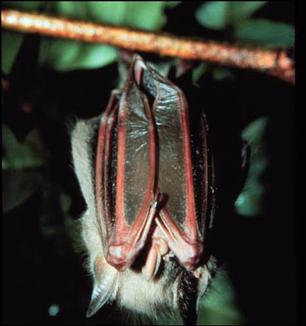
The red fruit bat or red fig-eating bat is a species of bat in the family Phyllostomidae, in the monotypic genus Stenoderma. It is found in Puerto Rico and the U.S. Virgin Islands.

The Ugandan red colobus or ashy red colobus is an endangered species of red colobus monkey, recognised as a distinct species since 2001. There is disagreement however over taxonomy with many considering the Ugandan red colobus to be a subspecies. The Ugandan red colobus is an Old World monkey which is found in five different locations across Uganda and Tanzania.

Browsing is a type of herbivory in which a herbivore feeds on leaves, soft shoots, or fruits of high-growing, generally woody plants such as shrubs. This is contrasted with grazing, usually associated with animals feeding on grass or other lower vegetations. Alternatively, grazers are animals eating mainly grass, and browsers are animals eating mainly non-grasses, which include both woody and herbaceous dicots. In either case, an example of this dichotomy are goats and sheep.
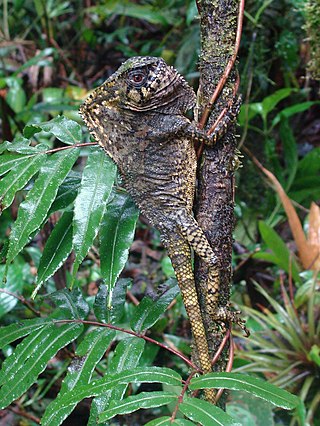
The smooth helmeted iguana, also known as the helmeted iguana, the helmeted basilisk, the elegant helmeted lizard, and several other common names, is a species of Basilisk and a New World lizard in the family Corytophanidae. The species is native to southern Mexico, Central America, and northwestern South America.

Pseudosphinx is a monotypic moth genus in the family Sphingidae first described by Hermann Burmeister in 1856. Its only species, Pseudosphinx tetrio, was first described by Carl Linnaeus in 1771. Its common names include tetrio sphinx, giant gray sphinx, frangipani hornworm, and plumeria caterpillar. In the island of Martinique it is best known as Rasta caterpillar because of its colors which are reminiscent of the ones found in Rastafarian clothing and accessories. It is native to the tropical and subtropical Americas from the southern and southwestern United States to Brazil. The occasional individual has been recorded as far north as the northeastern United States.

Simarouba amara is a species of tree in the family Simaroubaceae, found in the rainforests and savannahs of South and Central America and the Caribbean. It was first described by Aubl. in French Guiana in 1775 and is one of six species of Simarouba. The tree is evergreen, but produces a new set of leaves once a year. It requires relatively high levels of light to grow and grows rapidly in these conditions, but lives for a relatively short time. In Panama, it flowers during the dry season in February and March, whereas in Costa Rica, where there is no dry season it flowers later, between March and July. As the species is dioecious, the trees are either male or female and only produce male or female flowers. The small yellow flowers are thought to be pollinated by insects, the resulting fruits are dispersed by animals including monkeys, birds and fruit-eating bats and the seeds are also dispersed by leaf cutter ants.
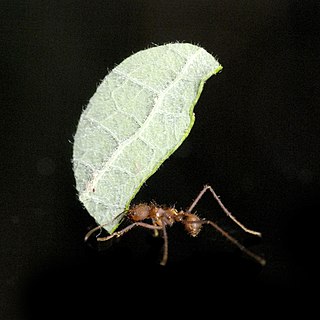
Atta colombica is one of 47 species of leafcutter ants. This species is part of the Attini tribe.

Platypodium elegans, the graceful platypodium, is a large leguminous tree found in the Neotropics that forms part of the forest canopy. It was first described by Julius Rudolph Theodor Vogel in 1837 and is the type species of the genus. The tree has been known to grow up to 30 metres in height and have a trunk with a diameter up to 1 m at breast height. Its trunk has large holes in it, sometimes making it possible to see through the trunk. The holes provide a habitat for giant damselflies and other insects both when alive and once the tree has died and fallen over. It has compound leaves each of which is made up of 10–20 leaflets. Three new chemical compounds have been isolated from the leaves and they form part of the diet of several monkeys and the squirrel Sciurus ingrami. In Panama it flowers from April to June, the flowers contain only four ovules, but normally only one of these reaches maturity forming a winged seed pod around 10 cm long and weighing 2 g. During the dry season around a year after the flowers are fertilised, the seeds are dispersed by the wind and the tree loses it leaves. The seeds are eaten by agoutis and by bruchid beetle larvae. The majority of seedlings are killed by damping off fungi in the first few months of growth, with seedlings that grow nearer the parent trees being more likely to die. The seedlings are relatively unable to survive in deep shade compared to other species in the same habitat. Various epiphytes are known to grow on P. elegans with the cactus Epiphyllum phyllanthus being the most abundant in Panama. Despite having holes in its trunk which should encourage debris and seeds to collect, hemiepiphytes are relatively uncommon, meaning that animals are not attracted to it to feed and then defecate. It has no known uses in traditional medicine and although it can be used for timber, the wood is of poor quality.

Drought deciduous, or drought semi-deciduous plants refers to plants that shed their leaves during periods of drought or in the dry season. This phenomenon is a natural process of plants and is caused due to the limitation of water around the environment where the plant is situated. In the spectrum of botany, deciduous is defined as a certain plant species that carry out abscission, the shedding of leaves of a plant or tree either due to age or other factors that causes the plant to regard these leaves as useless or not worth keeping over the course of a year. Deciduous plants can also be categorised differently than their adaptation to drought or dry seasons, which can be temperate deciduous during cold seasons, and in contrast to evergreen plants which do not shed leaves annually, possessing green leaves throughout the year.
Phyllis Dewing Coley is a Biology professor currently teaching at the University of Utah. In 1996 she received the University's Distinguished Research Award. She has been a research associate at the Smithsonian Tropical Research Institute since 1995. In 2023, she was elected to the National Academy of Sciences.
Rodolfo Dirzo is a professor, conservationist, and tropical ecologist. He is a Bing Professor in environmental science at Stanford and a senior fellow at the Stanford Woods Institute for the Environment. His research interests mainly focus on plant-animal interactions, evolutionary ecology, and defaunation in the tropics of Latin America, Africa, and the Central Pacific. He was a member of the Committee on A Conceptual Framework for New K-12 Science Education Standards, co-authoring the framework in 2012, and continues to educate local communities and young people about science and environmental issues.
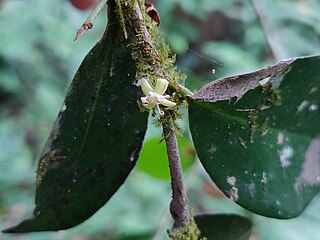
Drypetes wightii is an evergreen tree species endemic to the Western Ghats, India. The species is considered Vulnerable under the IUCN Redlist of Threatened Species.
John Massa Kasenene is a botanical and environmental ecologist, academic, scientist and academic administrator in Uganda. From 4 October 2022, he serves as the substantive Deputy Vice Chancellor of the Mountains of the Moon University (MMU), at that time, the tenth public university in the country.

















